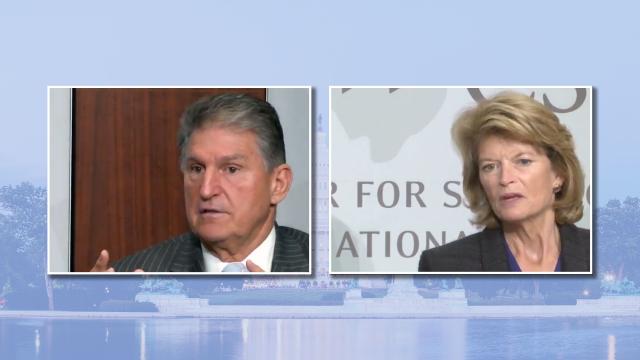
Sens. Joe Manchin, (D-W.Va.) and Lisa Murkowski (R-Alaska). (Source: Screen shots from Center for Strategic and International Studies event, Shutterstock)
Two senators who lead the Energy and Natural Resources Committee expressed frustration during a recent forum at the difficulty in filling the two open seats on the Federal Energy Regulatory Commission (FERC).
“If we just get a full working FERC it will be a miracle,” said Sen. Joe Manchin (D-W.Va.), ranking minority member of the committee, at an event sponsored by the Center for Strategic and International Studies in Washington, D.C., on Oct. 30. “We’re trying to get up to five members. We’re had three for quite some time.”
Former FERC Chairman Kevin McIntyre, a Republican, died on Jan. 3 and Cheryl LaFleur, a Democrat, stepped down in July. The White House nominated James Danly, the commission’s general counsel, on Oct. 1 to replace McIntyre but has yet to send up a Democratic replacement for LaFleur. Senate Minority Leader Chuck Schumer (D-N.Y.) recommended energy lawyer Allison Clements in February.
“I think that FERC as it was established was sound at the time but a lot has changed,” said Sen. Lisa Murkowski (R-Alaska), chair of the committee. “These types of reviews are not for the timid. What they have to go through from a regulatory review perspective is really pretty intense. Let’s give them the resources. They need a full complement.”
Danly appeared before the committee on Nov. 5 and is likely to be confirmed. However, Manchin expressed concern that the Trump administration has made no move to fill the open Democratic seat in what has traditionally been an apolitical commission.
“I have been vocal about the importance of pairing this nomination with a nominee for the open Democratic seat,” he said. “This is one committee that’s worked very well as a bipartisan committee. We’ve looked at the facts, looked at what’s best for our country and our regions, and been able to have input on both sides. Without any conflicts whatsoever. And to put us in a situation to where we can have a conflict, and it could be avoided, is just not right.”
The empty seats on FERC have meant, for Manchin, that needed pipelines cannot be built in West Virginia.
“My state is shut down for the Marcellus and Utica shale,” he said.
Both senators represent states that are rich in fossil fuels but with populations that struggle with energy issues. In Alaska, it’s about the cost of transporting energy to isolated communities.
“You’ve got a small community of, say, 500 people,” Murkowski said. “There’s no natural gas pipeline that’s coming to you. The oil comes to you, yes, but it’s produced up north, it’s shipped down to the Lower 48 and then it’s sent back to Alaska so by the time it gets to your community on the Yukon River, you’re paying $8, $9, $10 a gallon. That’s not sustainable.”
Those communities that have been reliant on diesel are turning to other sources, like renewables, to power microgrids.
In West Virginia, the issue is jobs. Increased automation in the coal mines has cost jobs that have not been replaced in the shale fields. When the Obama administration began pushing renewables, the state was all in and in fact is home to one of the largest wind farms, Mount Storm, east of the Mississippi, Manchin said. But the employment problem persists.
“We just don’t see the bump in employment that had gone with coal,” he said.
Both senators—who noted that they get along well, which is not that common among lawmakers of different parties—had solutions in mind. For Manchin, states like West Virginia that have provided energy reliance through coal need tax incentives as the country transitions to cleaner energy.
Murkowski is a fan of innovation but stressed that ideas aren’t enough. They need to be implemented and that is a challenge.
“We have a ways to go with that,” she said. “Some of it is regulation, some of it is those who say, ‘I don’t care what gains you have made in efficiencies, you’re still dealing with a fossil-based energy source and I don’t want it to go anywhere.’ And so you’ve got those naysayers that hold you back.”
Recommended Reading
Diamondback to Sell $2.2B in Shares Held by Endeavor Stockholders
2024-09-20 - Diamondback Energy, which closed its $26 billion merger with Endeavor Energy Resources on Sept. 13, said the gross proceeds from the share’s sale will be approximately $2.2 billion.
Optimizing Direct Air Capture Similar to Recovering Spilled Wine
2024-09-20 - Direct air capture technologies are technically and financially challenging, but efforts are underway to change that.
Analyst: Is Jerry Jones Making a Run to Take Comstock Private?
2024-09-20 - After buying more than 13.4 million Comstock shares in August, analysts wonder if Dallas Cowboys owner Jerry Jones might split the tackles and run downhill toward a go-private buyout of the Haynesville Shale gas producer.
Matador Offers $750 Million in Senior Notes Following Ameredev Deal
2024-09-20 - Matador Resources will offer $750 million in senior notes following the close of its $1.83 billion Ameredev II acquisition.
Aethon, Murphy Refinance Debt as Fed Slashes Interest Rates
2024-09-20 - The E&Ps expect to issue new notes toward redeeming a combined $1.6 billion of existing debt, while the debt-pricing guide—the Fed funds rate—was cut on Sept. 18 from 5.5% to 5%.
Comments
Add new comment
This conversation is moderated according to Hart Energy community rules. Please read the rules before joining the discussion. If you’re experiencing any technical problems, please contact our customer care team.






